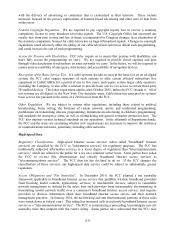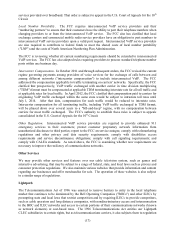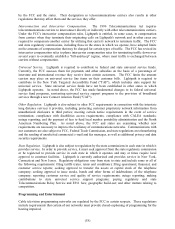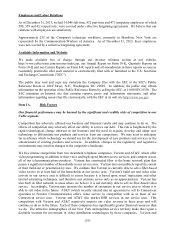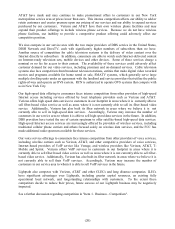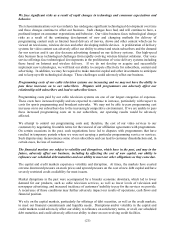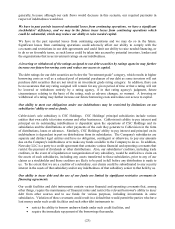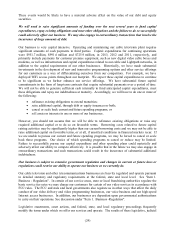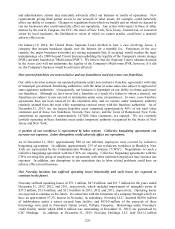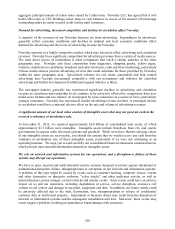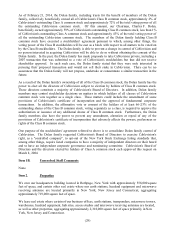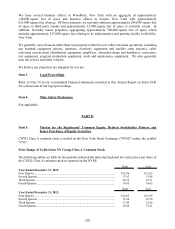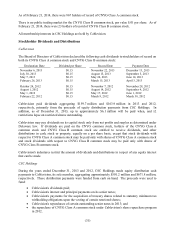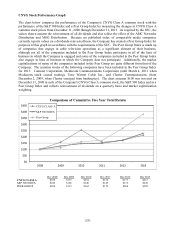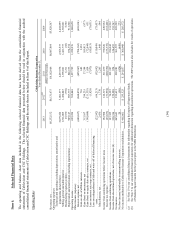Cablevision 2013 Annual Report Download - page 30
Download and view the complete annual report
Please find page 30 of the 2013 Cablevision annual report below. You can navigate through the pages in the report by either clicking on the pages listed below, or by using the keyword search tool below to find specific information within the annual report.(24)
These events would be likely to have a material adverse effect on the value of our debt and equity
securities.
We will need to raise significant amounts of funding over the next several years to fund capital
expenditures, repay existing obligations and meet other obligations and the failure to do so successfully
could adversely affect our business. We may also engage in extraordinary transactions that involve the
incurrence of large amounts of debt.
Our business is very capital intensive. Operating and maintaining our cable television plant requires
significant amounts of cash payments to third parties. Capital expenditures for continuing operations
were $951.7 million, $991.6 million and $725.9 million, in 2013, 2012 and 2011, respectively, and
primarily include payments for customer premise equipment, such as new digital video cable boxes and
modems, as well as infrastructure and capital expenditures related to our cable and Lightpath networks, in
addition to the capital requirements of our other businesses. Historically, we have made substantial
investments in the development of new and innovative programming options and other service offerings
for our customers as a way of differentiating ourselves from our competitors. For example, we have
deployed WiFi access points throughout our footprint. We expect these capital expenditures to continue
to be significant as we further enhance our service offerings. We have substantial future capital
commitments in the form of long-term contracts that require substantial payments over a period of time.
We will not be able to generate sufficient cash internally to fund anticipated capital expenditures, meet
these obligations and repay our indebtedness at maturity. Accordingly, we will have to do one or more of
the following:
x refinance existing obligations to extend maturities;
x raise additional capital, through debt or equity issuances or both;
x cancel or scale back current and future spending programs; or
x sell assets or interests in one or more of our businesses.
However, you should not assume that we will be able to refinance existing obligations or raise any
required additional capital or to do so on favorable terms. Borrowing costs related to future capital
raising activities may be significantly higher than our current borrowing costs and we may not be able to
raise additional capital on favorable terms, or at all, if unsettled conditions in financial markets recur. If
we are unable to pursue our current and future spending programs, we may be forced to cancel or scale
back those programs. Our choice of which spending programs to cancel or reduce may be limited.
Failure to successfully pursue our capital expenditure and other spending plans could materially and
adversely affect our ability to compete effectively. It is possible that in the future we may also engage in
extraordinary transactions and such transactions could result in the incurrence of substantial additional
indebtedness.
Our business is subject to extensive government regulation and changes in current or future laws or
regulations could restrict our ability to operate our business as we currently do.
Our cable television and other telecommunications businesses are heavily regulated and operate pursuant
to detailed statutory and regulatory requirements at the federal, state and local level. See "Item 1.
Business - Regulation". In certain of our service areas, state or local franchising authorities regulate the
basic service tier rates we may charge our customers for certain of our video services in accordance with
FCC rules. The FCC and state and local governments also regulate us in other ways that affect the daily
conduct of our video delivery and video programming businesses, our voice business and our high-speed
Internet access businesses. In addition, our businesses are dependent upon governmental authorizations
to carry on their operations. See discussion under "Item 1. Business -Regulation".
Legislative enactments, court actions, and federal, state, and local regulatory proceedings frequently
modify the terms under which we offer our services and operate. The results of these legislative, judicial



